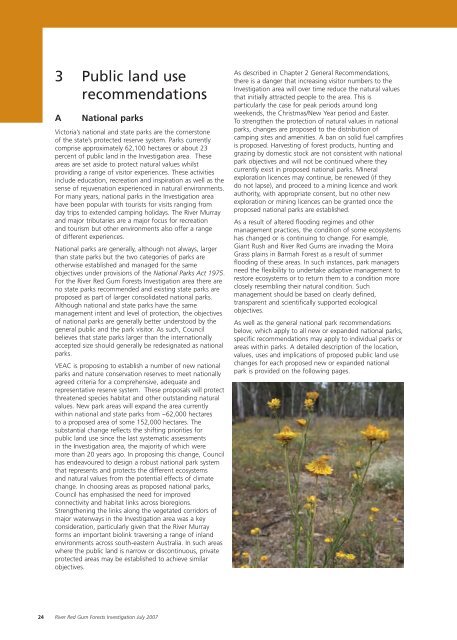Draft Proposals Paper - Full - Victorian Environmental Assessment ...
Draft Proposals Paper - Full - Victorian Environmental Assessment ...
Draft Proposals Paper - Full - Victorian Environmental Assessment ...
Create successful ePaper yourself
Turn your PDF publications into a flip-book with our unique Google optimized e-Paper software.
3 Public land use<br />
recommendations<br />
A<br />
National parks<br />
Victoria’s national and state parks are the cornerstone<br />
of the state’s protected reserve system. Parks currently<br />
comprise approximately 62,100 hectares or about 23<br />
percent of public land in the Investigation area. These<br />
areas are set aside to protect natural values whilst<br />
providing a range of visitor experiences. These activities<br />
include education, recreation and inspiration as well as the<br />
sense of rejuvenation experienced in natural environments.<br />
For many years, national parks in the Investigation area<br />
have been popular with tourists for visits ranging from<br />
day trips to extended camping holidays. The River Murray<br />
and major tributaries are a major focus for recreation<br />
and tourism but other environments also offer a range<br />
of different experiences.<br />
National parks are generally, although not always, larger<br />
than state parks but the two categories of parks are<br />
otherwise established and managed for the same<br />
objectives under provisions of the National Parks Act 1975.<br />
For the River Red Gum Forests Investigation area there are<br />
no state parks recommended and existing state parks are<br />
proposed as part of larger consolidated national parks.<br />
Although national and state parks have the same<br />
management intent and level of protection, the objectives<br />
of national parks are generally better understood by the<br />
general public and the park visitor. As such, Council<br />
believes that state parks larger than the internationally<br />
accepted size should generally be redesignated as national<br />
parks.<br />
VEAC is proposing to establish a number of new national<br />
parks and nature conservation reserves to meet nationally<br />
agreed criteria for a comprehensive, adequate and<br />
representative reserve system. These proposals will protect<br />
threatened species habitat and other outstanding natural<br />
values. New park areas will expand the area currently<br />
within national and state parks from ~62,000 hectares<br />
to a proposed area of some 152,000 hectares. The<br />
substantial change reflects the shifting priorities for<br />
public land use since the last systematic assessments<br />
in the Investigation area, the majority of which were<br />
more than 20 years ago. In proposing this change, Council<br />
has endeavoured to design a robust national park system<br />
that represents and protects the different ecosystems<br />
and natural values from the potential effects of climate<br />
change. In choosing areas as proposed national parks,<br />
Council has emphasised the need for improved<br />
connectivity and habitat links across bioregions.<br />
Strengthening the links along the vegetated corridors of<br />
major waterways in the Investigation area was a key<br />
consideration, particularly given that the River Murray<br />
forms an important biolink traversing a range of inland<br />
environments across south-eastern Australia. In such areas<br />
where the public land is narrow or discontinuous, private<br />
protected areas may be established to achieve similar<br />
objectives.<br />
As described in Chapter 2 General Recommendations,<br />
there is a danger that increasing visitor numbers to the<br />
Investigation area will over time reduce the natural values<br />
that initially attracted people to the area. This is<br />
particularly the case for peak periods around long<br />
weekends, the Christmas/New Year period and Easter.<br />
To strengthen the protection of natural values in national<br />
parks, changes are proposed to the distribution of<br />
camping sites and amenities. A ban on solid fuel campfires<br />
is proposed. Harvesting of forest products, hunting and<br />
grazing by domestic stock are not consistent with national<br />
park objectives and will not be continued where they<br />
currently exist in proposed national parks. Mineral<br />
exploration licences may continue, be renewed (if they<br />
do not lapse), and proceed to a mining licence and work<br />
authority, with appropriate consent, but no other new<br />
exploration or mining licences can be granted once the<br />
proposed national parks are established.<br />
As a result of altered flooding regimes and other<br />
management practices, the condition of some ecosystems<br />
has changed or is continuing to change. For example,<br />
Giant Rush and River Red Gums are invading the Moira<br />
Grass plains in Barmah Forest as a result of summer<br />
flooding of these areas. In such instances, park managers<br />
need the flexibility to undertake adaptive management to<br />
restore ecosystems or to return them to a condition more<br />
closely resembling their natural condition. Such<br />
management should be based on clearly defined,<br />
transparent and scientifically supported ecological<br />
objectives.<br />
As well as the general national park recommendations<br />
below, which apply to all new or expanded national parks,<br />
specific recommendations may apply to individual parks or<br />
areas within parks. A detailed description of the location,<br />
values, uses and implications of proposed public land use<br />
changes for each proposed new or expanded national<br />
park is provided on the following pages.<br />
24 River Red Gum Forests Investigation July 2007
















